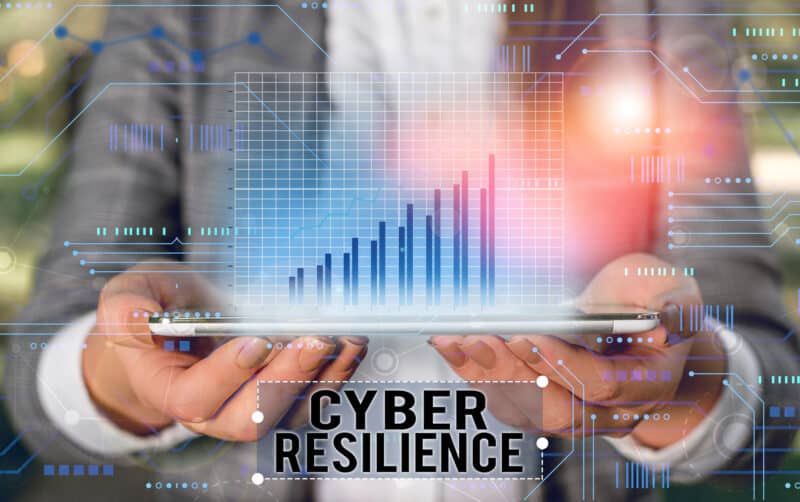Every organization worldwide is vulnerable to cyberattacks, data breaches, and damage to critical systems, which can have long-lasting impacts. The average cost of a data breach escalated to $4.88 million in 2024. Furthermore, these direct financial impacts are augmented by potential legal consequences, lingering interruptions in business continuity, and damage to your organization’s reputation that sticks.
Virtually every company has specific cybersecurity and data protection measures to minimize the risk of a cyberattack, but what about a cyber resilience strategy?
What is Cyber Resilience?
Cyber resilience refers to the essentials of cybersecurity, but a cyber resilient organization has a layer of additional protection against cyber events, future threats, and post-attack response.
A proactive cyber resilience strategy enables a business to recover quickly, maintain essential services, assets, and functions, and minimize disruptions caused by a cybersecurity incident. Read on to discover the fundamentals of a complete cyber resilience strategy.
We will also cover more about how your company can ensure that cybersecurity and cyber resilience are cornerstones of your operations providing better cyber risk protection and the ability to quickly recover when disaster strikes.
Table of Contents
Cyber Resilience vs Traditional Cybersecurity
The Five Pillars of Cyber Resilience
Different Types of Cyberthreats
Understanding Vulnerability
Cybersecurity and Cyber Resilience with our Experts
Understanding Why Cyber Resilience is Critical for Businesses
Cyber resilience is an organization’s ability to weather adverse events that impact critical infrastructure and cyber resources in a computer environment.
The National Institute of Standards and Technology (NIST) defines cyber resilience as “the ability to anticipate, withstand, recover from, and adapt to adverse conditions, stresses, attacks, or compromises on systems that use or are enabled by cyber resources.” However, this broad definition tends to become more refined as organizations build cyber resilience strategies and business continuity plans unique to their data and systems.

Cyber resilience vs. traditional cybersecurity
When discussing an organization’s security, cyber resilience and cybersecurity are very similar. However, understanding the differences between the two is important. Cybersecurity and cyber resilience focus on putting iron-clad security measures in place to protect an organization’s IT infrastructure from a range of risks and attacks.
This can include protection against threat actors, and measures to protect systems from more innocuous events like human error, natural disasters, and power outages.
The main difference between cybersecurity and cyber resilience boils down to the response. Cybersecurity focuses on protecting mission critical systems and data, but cyber resilience includes strategies to streamline disaster recovery.
Cyber resilience encompasses all the solutions and plans that allow a business to respond quickly after an attack or other threat to a company’s systems. Hence, the damage to systems and data is minimal.

The 5 Pillars of Cyber Resilience
Effective cyber resilience is a multifaceted venture. Both cybersecurity and cyber resilience focus on protecting business operations from external and internal threats. However, the core components of cyber resilience go miles beyond simple risk management and data protection and focus on what comes after an attack or devastating incident for effective disaster recovery solutions.
The pillars of cyber resilience include the following.
Identify
Before business continuity plans and solutions can be formed, an intricate and in-depth knowledge of an organization’s distinctive risks is required. Creating a thorough accounting of risks and threats that can impact business continuity and an organization’s ability to function includes the following.
- Asset management and cybersecurity risk assessment – This includes taking stock of all the systems and IT infrastructure connected to your organization, which could be infiltrated and/or damaged by an attack or other potential threat. This long list includes primary on-premises systems in business operations, like your servers, software, and hardware. It can also include the data and programs that your end users connect to every day (as well as the devices connected to your business).
- Business environment analysis – This facet of the identify stage examines gaps in security and weak links in business operations that are highly susceptible to potential threats, like outdated or unpatched systems or essential systems and software without privilege restrictions in place.
- Governance structures and overall risk management strategy guidelines –Depending on their industry, many organizations may have legal or regulatory cybersecurity guidelines that must be followed. Researching these security guidelines and ensuring essential protection measures are in place to ensure compliance is a cornerstone of developing a cybersecurity and cyber resilience plan.
Protect
Once an organization identifies common vulnerabilities and potential threats, it needs to ensure that all protection solutions are in place. Again, these cybersecurity initiatives are individualized for every organization and business, but these steps may include the following.
- Access control and least privilege principle – Not everyone connected to your organization should have the same access privileges to your systems and data. Therefore, implementing access management is important for building a cyber resilient system for your business.
- Data security and information protection processes – Make sure your data is continually protected against risks and potential attacks, primarily if you regularly work with sensitive data. (Companies with sensitive data like financial, healthcare, and other personal information tend to be most at risk of a data breach.) In addition to implementing data protection measures, it’s also important to facilitate regular data backups to ensure your business can recover quickly if an attack occurs.
- Protective technology implementation – A cybersecurity and data recovery solutions expert like DartPoints can help you explore your options for implementing more advanced protective technologies to ensure better, streamlined security. This may include artificial intelligence options that can make scanning and protecting your data automated and continually operational.

Detect
Early detection helps ensure that an attack or other disaster doesn’t spiderweb into a massive security breach or security incident that entirely disrupts business continuity.
- Continuous monitoring and detection processes – You should have security technologies constantly monitor your business’s systems and IT infrastructure for potential threats or evolving risks.
- Anomalies and events detection –Most importantly, these security technologies should be able to pinpoint and immediately address any anomalies that may indicate a potential threat.
- On-premises security – Monitoring your business systems and IT infrastructure is essential, as is monitoring the equipment at your business’s physical location. Make sure you have robust security measures for your essential equipment, or take steps to protect your critical systems, like housing your servers in a modern and secure colocation facility.
Respond and Recover
Staying ahead of the risks and attacks that can affect your business is essential. However, a solid cyber resilience plan also has instructions on how to respond best after a risk or cyberattack comes to realization and becomes an organization’s emergency
Analysis and mitigation strategies
These cyber resilience strategies focus on the most likely cyber risks and the systems crucial for continual business operations. First, prioritize the systems and data that need to be recovered and protected in an event of an attack. Then, create concrete steps to restore services and get back online as quickly as possible.
Response planning and communications
A cornerstone of disaster recovery is to ensure that everyone on your team knows how to respond in an emergency. Appoint key roles for different aspects of disaster recovery after an attack and ensure that you have a communications system in place to keep everyone on the same page. If an attack occurs, everyone connected to your organization must be notified of the steps your business takes to resolve the problem. Make sure that your lines of communication are solid and can continue even if critical systems are down and typical communication channels are not operational.
Protect and restore systems and data
Organizations must not underestimate the importance of continuous data and systems backups. Ensuring that regular backups are available guarantees an organization’s ability to bounce back after an attack or other security incident as soon as possible. Furthermore, it will protect all the critical information and technologies a business needs. Again, a cybersecurity and cyber resilience expert like DartPoints can help protect systems and data by ensuring a copy of this essential info is available and secure.
Review and revise
The only silver lining of an attack or other emergency that impacts a business is that it presents an opportunity to review a cyber resilient strategy and identify gaps or needed changes. Even if a risk or threat doesn’t become a severe issue, it’s important to constantly review your cyber risk vulnerability and take new steps to protect your business as needed. Cybersecurity threats are continually evolving, and business solutions have to evolve as well to stay ahead of threats.

Different Types of Cyberthreats
Cyberattacks can take various forms that are always evolving and becoming more sophisticated. The following are samples of different types of attacks that can affect business systems and continuity.
Ransomware
Ransomware is an attack where bad actors hold an organization’s systems and data hostage until the business takes specific dictated steps, like paying money to retrieve access to their systems once again. Furthermore, ransomware attacks tend to occur when a malicious program infiltrates an organization’s system by exploiting vulnerabilities in software, tricking users into clicking on malicious links, or gaining access through compromised channels and privileges.
Phishing
Phishing attacks occur when a bad actor impersonates a trustworthy source to gain access to systems and/or data. Additionally, they are most commonly successful due to simple human error. For example, a bad actor may send a legitimate- looking email or social media message or call an individual within a business and impersonate another higher official within the organization.
Supply Chain Attacks
Supply chain attacks tend to use backdoor methods to infiltrate software and systems, trickling into any organization connected to the targeted victim. This allows the threat actors to deliver automated patches or “trojanized” software updates that open the door for malware and other attacks, which can quickly spread to third-party vendors, consumers, and other connected parties. However, supply chain attacks can be brutally detrimental. They impact multiple organizations and end users who rely on the compromised products and services.

Understanding vulnerability
When it comes to cyberattacks, individual organizations can be impacted in multiple ways.
The ripple effect
Even if your business is not the direct victim of an attack, a cyberattack on one business that is connected to your organization can infiltrate your systems. This is the most challenging cybersecurity risk to navigate, simply because the security measures that other organizations use (or don’t use) are out of your control.
User vulnerability
Effective training is required for every member of your team to ensure that your employees know what to look for when it comes to phishing, ransomware, and other attacks that only require one instance of human error to be effective.
Outdated software
Software manufacturers and companies regularly issue updates when they detect new threats. Delaying the upgrade of your software and systems may impact your entire business.
Lack of cybersecurity
Not having standard cybersecurity measures in place, like advanced firewalls and limited access privileges, can naturally leave your systems vulnerable to attacks.

Cybersecurity and cyber resilience with our experts at DartPoints
A cyber resilience strategy is both complex and constantly evolving. In addition, most organizations simply don’t have the resources to ensure that every type of risk is mitigated, and every aspect of a business is protected.
That’s why you need an expert resource to help comb through all the aspects of cyber resilience and ensure your business can stay ahead of attacks and recover without disruption if a crisis occurs.
Your business operations depend on your ability to function on a day-to-day level. That is why it’s important to have the right cybersecurity for your data and systems. Data breach or cybersecurity incident can have broad financial and reputational implications that linger long after the attack has been resolved.
Don’t wait until an attack occurs to launch disaster recovery measures. Have a plan in place now that will minimize downtime and ensure data protection and business continuity no matter how or when a threat arises.
Reach out to DartPoints today.
Discover a cybersecurity and cyber resilience resource that will offer blankets of protection and actionable solutions, no matter what comes.
